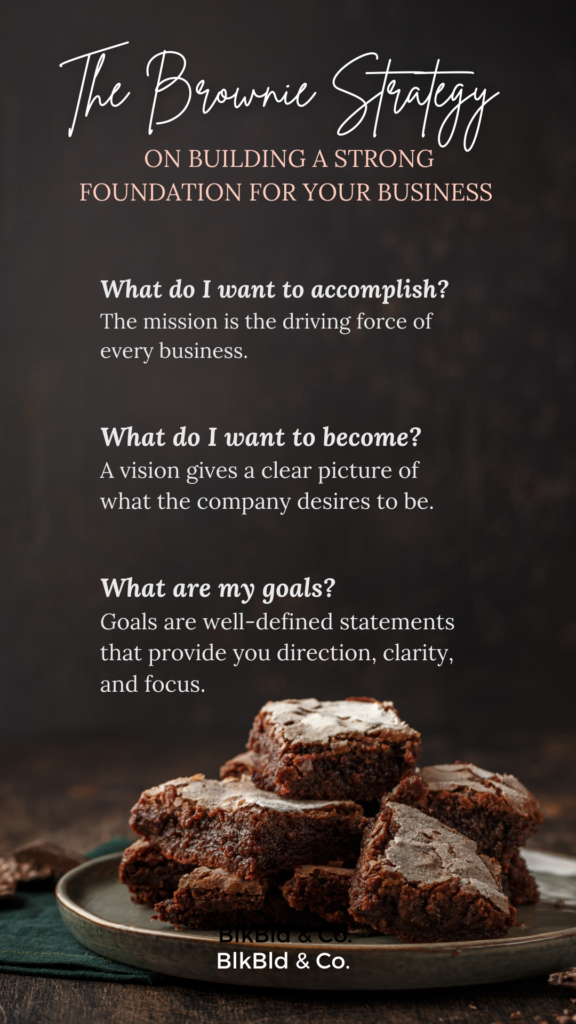
Building a Strong Foundation for Your Business – The Brownie Strategy
- Branding, Business Development, Business Mindset, Marketing
- Automation, Business Loyalty, Social Media Engagement, Tips and Tricks
- October 10, 2021
Starting a business is an enormous task, and it can be an intimidating endeavor. It requires a lot of putting together essential components to build a successful company. First, the business must have a distinct personality and determine and establish its position in the local or global market. This way, it will surely stand out, appeal to the right clients, and guarantee a positive outcome.
So, how do you start building a solid foundation for your business? I created a technique called the Brownie Strategy that can help you get the ball rolling. With this, hopefully, you’ll be able to build the momentum you need to grow your business venture. But first, what is this Brownie Strategy anyway?

What is the Brownie Strategy?
The Brownie Strategy illustrates how building a strong business foundation allows you to get the results you are looking for. Like baking a brownie, you must have clear guidelines on what ingredients to add, when to do it, and the time frames for each activity.
You’re not just dumping all of the ingredients into your bowl. Instead, you put all those ingredients together, pop it in the oven, and you let it bake. Building a business is the same, and just like baking a brownie, you want to know that you’ll get the desired outcome.
Similarly, in business, you must know the ingredients you need to be successful.
- Know your mission – who you are, who you serve, and how you serve them.
- Have a clear vision of where you are going and the strategy to get there.
- You must know your values – who are you trying to be? Create a set of guiding principles and fundamental beliefs that will help your organization work together as a team while you work toward your common business goal.
- Set your goals – know where you would like your business to be in the next year and the next 5 to 10 years and what you need to do to reach your business goals.
Once all the ingredients are in your pan, let it bake. Give your brownie the time it needs to bake—many businesses pivot and change before the baking process is over. However, constantly changing rather than just sticking to the main idea will cause the business to fail because you’ll be doing too much simultaneously versus letting your business bake, so to speak, and learning from it and optimizing it.
If there is one thing COVID has taught us, pivoting is essential to see success in our business. But, there is a difference between pivoting once you’ve gained feedback from your clients versus running after many unrelated ideas at once. So what we are advising here is don’t run after the next brownie right away. Instead, let your first brownie bake and change a few things here and there, but let it do what it needs to do. And then maybe, when you’ve tasted that batch of brownies, you’ll know what to add, subtract, or if you need to do things differently so that you’ll have much better brownies for the next round.
It’s similar in the business world. There are so many things that can be improved once you’re done testing the waters. What’s important is to set things in motion, assess the results, and then improve.
How do you build a strong foundation for the business?
We should not underestimate the importance of a solid foundation in the success of our business and in unlocking the right clients. It is a critical component for establishing your business and communicating who you are, the products or services you offer, and what makes you different from competitors.
To eliminate confusion, answer the following three questions:
1 – What do I want to accomplish?
The mission is the driving force of every business. The reason and purpose of the business’s existence is the guiding principle that gives direction towards the company’s ultimate destination.
“A mission statement defines what an organization is, why it exists, its reason for being. At a minimum, your mission statement should define who your primary customers are, identify the products and services you produce, and describe the geographical location in which you operate.”
– entrepreneur.com
Unfortunately, so many small businesses start without a clear mission of who they are, what they value, no vision on what they want to become, and no strategy on what it will take to get there.
A good indicator of an excellent business plan is that it’s realistic and achievable. One of the many challenges a startup business may face is having to address everything simultaneously. To avoid the unnecessary accumulation of things to do, prioritize setting a clear mission statement.
2 – What do I want the business to become?
A vision gives a clear picture of what the company desires to be. A clearly defined vision drives and propels you forward as it generates a mental image of the kind of business you are working to achieve. When you set up a business, it is inherent that you look at what will happen years from now.
The company’s vision is the compass that will guide you in the right direction. It helps you in your decision-making process, especially when it comes to pursuing opportunities and whether it will bring you closer to what you want to accomplish.
With a vision, you can also measure the progress of the business, set goals, and establish priorities. And lastly, having a vision for your company will help you focus on the vital tasks while discarding the rest that only wastes your time.
3 – What are my business goals?
Your goals are well-defined statements that provide you with direction, clarity, and focus. Having goals means that you have defined a set of metrics to use to move closer to your vision. What are your goals for your business in the next three months and the next three years? Have short-term as well as long-term goals.
The famous quote from Antoine de Saint-Exupéry, “A goal without a plan is just a wish.” This is also true in terms of business goals and planning. You are set to fail if you join the business world without a well-thought plan.
The goals of your business are defined by human capital, operational efficiency, marketing, customer service, and of course, revenue and sales. These are functional areas of the business that need to have one goal within the first 90 days. You don’t need a lot of goals. Focus on one to three. You can start by basing it on your client acquisition and revenue.
To make goal-setting easier, you can use the SWOT analysis. It stands for Strengths, Weaknesses, Opportunities, and Threats. Using this will allow you to identify the strong points and the weak points in your business and how you can use them to your advantage. Don’t forget to be as specific as possible when you’re setting goals for your business so you’ll have a clear target to aim for.
Takeaway
Whenever you’re confused or intimidated by the thought of starting a business venture, remember the Brownie Strategy. Building a business is similar to baking but on a larger scale. First, you need to know the necessary ingredients, the correct procedure, and the right time for the brownies to bake.





